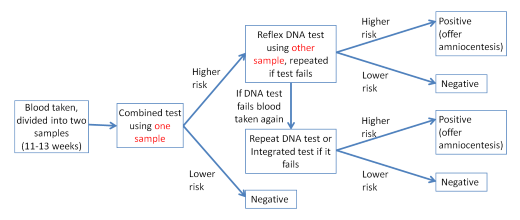Reflex DNA Screening
An implementation project for reflex DNA screening using αlpha software has been completed and published in Genetics in Medicine (Read here). The screening performance is close to previous modelled estimates. Reflex DNA screening compared with universal DNA screening (sometimes called non-invasive prenatal testing, NIPT) provides, at a lower cost, a substantially lower false positive rate (and hence reduced anxiety) for a small loss in detection rate and avoids the problem of failed DNA tests. Further information about the cost of reflex DNA screening is given in this article and at screening-cost-calculator.com
In reflex DNA screening (References 1 & 2) the risk of a pregnancy being affected with Down's syndrome, trisomy 18 or trisomy 13 is initially determined using a first trimester, second trimester or Integrated test. Women with a risk greater than or equal to a specified cut-off automatically have a maternal plasma DNA test to determine the risk of the pregnancy being affected with one of these disorders (see figure). Women with a risk below the cut-off receive no further testing. The cut-offs used are set so that a small fraction of the women (for example 10%) receive the DNA test. Both serum and plasma samples are taken at the same time so, if a DNA test is necessary, the second blood sample can be used so that the patient does not have to be recalled for a second time.

Flow chart of reflex DNA testing with the Combined test (adapted from reference 1)
The table below compares reflex DNA screening with screening using the Combined test and with universal DNA testing. A high screening performance can be achieved through reflex DNA screening with a false positive rate about one-eighth that of universal DNA screening with a relatively small loss in detection.
| Screening method | Detection rate (%) | False-positive rate (%) | False-positive rate plus failed tests requiring fresh blood sample (%) |
|---|---|---|---|
|
Reflex DNA testing Estimated from modelling (ref 2) Results of Implementation Project (ref 3) |
91 95 |
0.02 0.02 |
0.3 0.2 |
| Combined Test in Implementation Project (risk cut-off 1 in 150) (ref 3) | 81 | 2.4 | 2.4 |
| Universal DNA testing (ref 4) | 98 | 0.2 | 2.7 |
Antenatal screening for Down's syndrome: comparison of reflex DNA screening with screening using the combined test and universal DNA testing
αlpha implements the reflex DNA screening protocol and includes the following features:
- Separate Down’s syndrome, trisomy 18 and trisomy 13 cut-offs for reflex DNA screening are provided.
- Following a combined, quadruple or Integrated test, αlpha automatically identifies those patients who require a reflex DNA test and issues a “reflex DNA test alert” in respect of these patients.
- When the DNA results are received, the results are entered into αlpha and a screening result issued. Failed DNA tests and repeated DNA test results are also recorded so that a full audit trail of results is maintained for each patient.
- A facility is provided in αlpha to keep track of patients who have not yet received their DNA test result so that these can be followed up if necessary.
- Statistical summaries of the results of patients having reflex DNA screening are generated automatically.
References:
1. Incorporating DNA Sequencing into Current Prenatal Screening Practice for Down’s Syndrome (2013)
2. Performance of antenatal reflex DNA screening for Down’s syndrome (2015)
3. Prenatal reflex DNA screening for trisomy 21, 18, and 13 (2017)
4. DNA sequencing of maternal plasma to detect Down syndrome: an international clinical validation study. (2011)